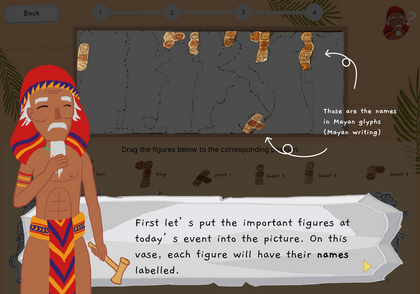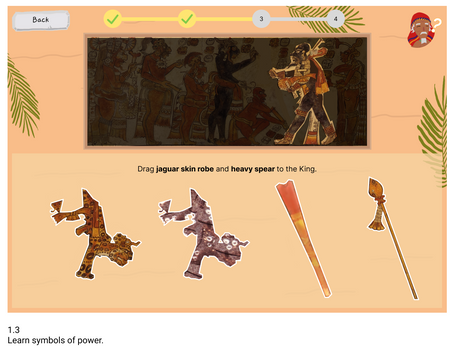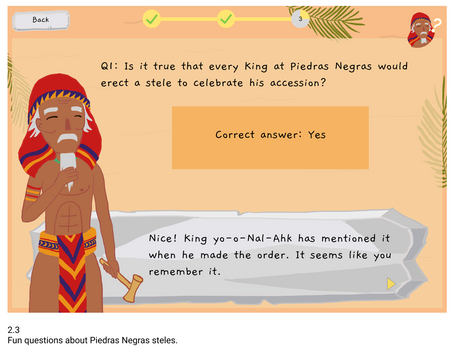Little Mayan Artisan
A game designed to enhance children's learning experience at Penn Museum.
Independent Project Fall 2022
Overview
The Challenge
Due to the difficulty in understanding the heavy text and the lack of interaction in the museums, children are not very attracted to the museums and are not able to acquire as much knowledge as expected.
The Outcome
My solution to this problem is creating an interactive educational game that is integrated with the objects being displayed.
Little Mayan Artisan is produced specifically for the Central American Gallery at Penn Museum.
Highlight Features Display
01
2 games are made, 1 for each of the 2 chosen gallery objects. It covers a broad range of knowledge, including meaning of colors, Mayan writings, ect.
Detailed and easy-to-follow instructions and fun knowledges are given.
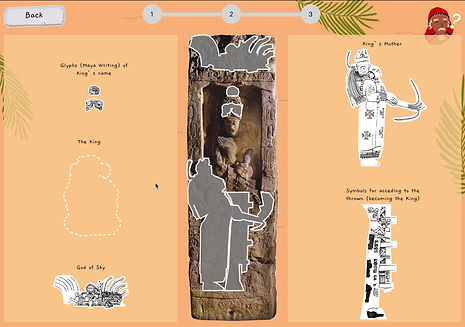
02
With totally 7 sublevels, there are different interaction modes and multiple ways to play.
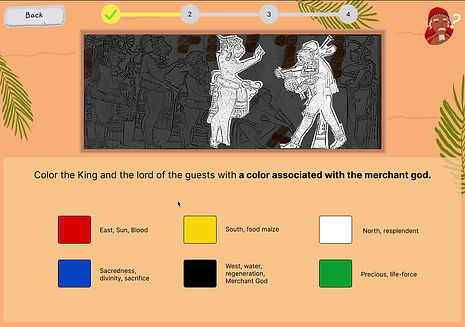
03
Instant, encouraging feedbacks are given, to keep the players informed and motivated.
Research
Literature Review
After studing educational psychology textbooks and reading articles on museum education and current trends, I had the 2 main take aways:
1
I studied Piaget’s theory of four stages of cognitive development, and decided that the third stage, Concrete Operational stage (about 7~15 years), is the best audience for our museum project for the following reasons:
Children in the first two stages are:
-
still developing their understanding of the physical world
-
illiterate due to young age
-
egocentric and cannot understand different perspectives
With these limits, educational products can hardly bring different cultures to a deeper and more intersting level.
Have developed the ability to read long contents on their own, thus less help, guidance or stimuli are needed.
Sensorimotor
(0~2 years)
Preoperational
(2~7 years)
Concrete Operational
(elementary to middle school)
Formal Operational
(high school and college)
Children in this stage develop the ability of reading, and will achieve a complete and very logical system of thinking. They are ready to study more meaningful content.
Nonetheless, their reading and logical abilities are still development thus more guidance would be helpful to them.
I further studied the unique characteristics and corresponding teaching guidelines for children of Concrete Operational stage:
Abilities that children in this stage would develop:
-
Conservation:
realization that elements can be changed or transformed and still conserve many of their original characteritics
-
Classification:
classify objects based on one single characteristic. Develop the understanding that one class fits into another.
-
Reversibility:
can reverse a process mentally, such as classifying objects in a different way
-
Seriation:
ability to make orderly arrangement for more than one objects, such as A < B < C
-
Using visual aids: time lines, 3-D models, hierarchical branch diagrams.
-
Let students have chance to test objects, try out machines and do simple hand crafts.
-
Stories, readings, and instructions need to be brief and logical. Give them chance to practice first step before continuing.
-
Use familiar examples, relate complex ideas to their lives.
-
Give opportunity to classfy and group objects and ideas on increasingly complex levels.
-
Present open-ended questions (such as “how should the city deal with stray animals”), stimulate problem-solving discussions.
2
While museum is a great place for study to happen, it does not attract young people as much as digital products or entertainments.
Museum is a great place for study to happen because:
-
of their richness in collections and knowledge;
-
learning is most effective when it happens at multiple places and times rather than all at once. Museums can provides a different contexts.
-
learning is effective only when children can relate a new idea to their own experience. Museum is a great place for them to be exposed to different things thus
However, they are often not very attractive to young people because they did not keep up with the developing technologies.
Our competitor is Netflix and Candy Crush, rather than other museums.
------Sree Sreenivasan,
Chief Digital Officer of the Metropolitan Museum of Art in New York City
To solve this problem, museums have tried to incorporate phones, provide wifi to download museum app. There is also an upward trend on the emerge of children’s museums, designed specially for children.
Site Study
I visited Penn Museum, Museum of American Revolution and several other museums to study the current children-friendly set ups in the museums. There are some good examples that we can learn from:

1
Light up the patterns that are hard to see, and highlight some important patterns separately.

4
Interactive clothes-changing game.

2
A mix of 2D images and and 3D objects shows clearly how the objects are used.

3
A clear historical timeline.
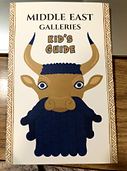


5
Children’s guide book with specialized navigation and interactive games, such as find differences and design your own jewery.
Interview
I interviewed 5 families with 7 children between 6~17 years old in the Penn Museum, and gained the following high level insights:

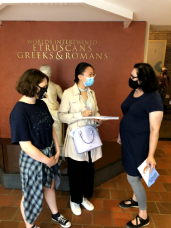
-
Parents want children to be exposed to different cultures, learn history, appreciate arts, and connect their experience to what they’ve learnt at school.
-
Children typically don’t read the texts, and need parents to answer their questions.
-
Some children can remember things better from experiences than from classroom.


-
Children don’t look at things one by one, they are attracted to huge, beautiful and very ancient objects.
-
Children don’t like repetitive and similar objects.
-
Children are not good at self-engagements. They want easier words, more interactive elements, more games and more touching.
Analysis
User Journey Map

Persona
Problem Statement
Due to the difficulty in understanding the heavy text and the lack of interaction in the museums, children are not very attracted to the museums and are not able to acquire as much knowledge as expected. We might solve this problem by creating interactive educational games that is integrated with the objects being displayed.
Ideation & Design
Brain Storm
Some early ideas:

For people who do not know that this is a light, it is hard to imagine how it is used. Thus we can make a game in which the players are asked to go throw the process of lighting it up and hanging/ placing it at the proper place.
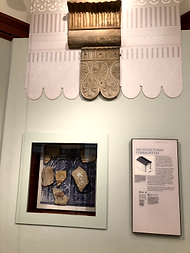
Wall/ architectural fragments can be put together to make a puzzle game. Drag the fragments to the proper place on an imagined reproduction image of the whole building. Starting from line drawings, after all pieces are put in, the user can see the colored reproduction image, which can be more impressive than just fragments.
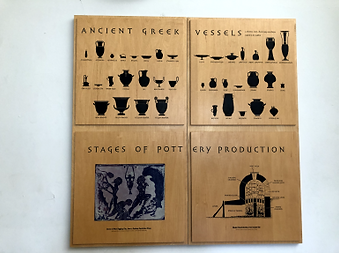
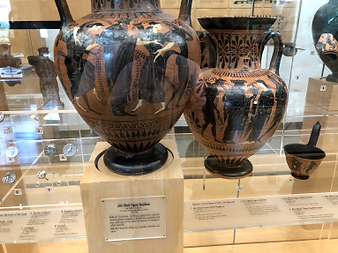
In the game we can choose a few of those silhouettes and ask the players to find the corresponding pots in the museum. They need to scan it when they find one, then they will unlock a 2-second animation showing the proper use of this kind of pot. In this way, the players could immediately understand the purpose of the pot and gain some new knowledge in a blink of eye.
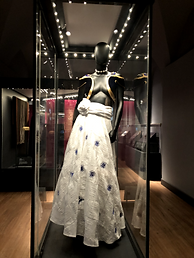

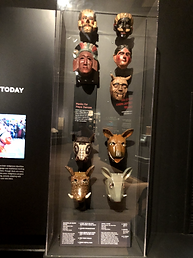
Dresses and masks can be made into a camera filter game, in which the users could try on different clothes through camera filters.
Prototype
Eventually I narrowed down and focused on only the Mayan portion of Central American Gallery. A story line of a grandpa teaching the grandson and taking orders from the Kings is produced, and 9 sublevels are designed.
Click on the picture to enlarge.

Game Design
Style collection + Mood Board
I collected many Mayan pictures and drawing from internet, especially ones with children-friendly styles. I learnt about tools, clothing, local architectures and environment from them, and eventually designed characters and elements in my games imitating the style of chosen pictures.


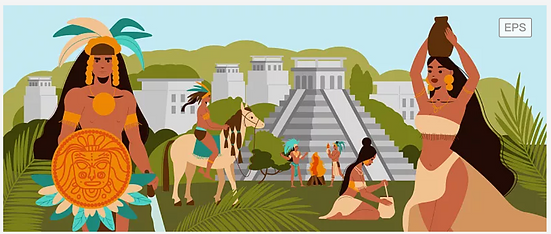

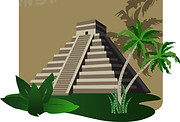

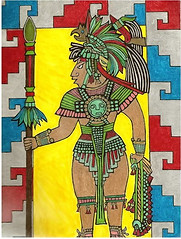

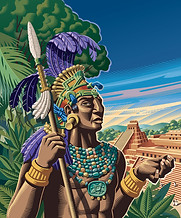


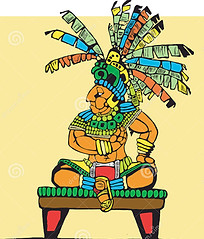
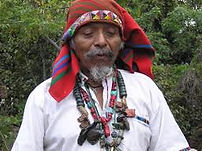
Character Design

Player
The player takes this role. He is the grandson of a great Mayan artisan, and study with his grandpa.

Grandpa
Grandpa is a great Mayan artisan, and takes order from the kings. He functions as the guide in the game.
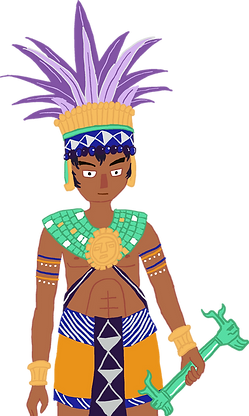
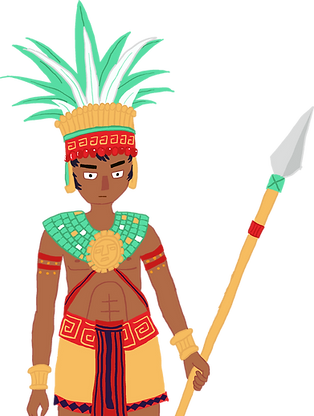
King 1
King Lo-no-ah. He ordered the grandpa to make a memorial vase.
King 2
King yo-o-Nal-Ahk. He ordered the grandpa to make a stele to celebrate his accession.
Element Design

Stone Board
Where information are placed.

Button - yellow
Primary Button.

Button - white
Secondary Button.

Background - Scene
Title page background.

Building
Decoration.

Background - Ground
In game background.


Plants
Decoration.
Mid-Fi Prototype
2 games and totally 7 sublevels are made, 1 for each of the 2 chosen objects in the Central American Gallery at Penn Museum.
Game 1: Vase of King Meeting 5 Guests
Game 2: Stele 14
Usability Study
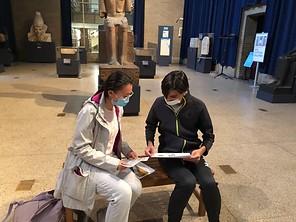
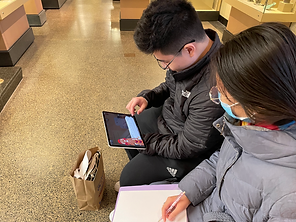


Totally 2 rounds of usability tests are done.
The first is tested with paper prototype. The test finds out that the game is too long for a museum setting and the instructions at many places are unclear and confusing. Thus I reduced the number of sublevels and redesigned the instruction and tutorials to smoothen the playing experience.
Then, the second round is done with an interactive demo on a tablet. The important findings and iterations from this test include:
-
The importance of instant and encouraging feedback.
-
More background information are expected by the users. It is too sudden to start with playing instruction directly.
-
Children would not always read the texts, so it is essential to make the important instructions noticeable, and it is better to incorporate the instructions into interactive tutorials rather than in text form.
-
Children like the drawing style of the game.
Reflection
Take Aways
I have learnt a lot from this project. I have learnt to build an interactive design model using Figma; I tried to design and draw out game characters and UIs for the first time. I have also learnt to think from the player's point of view, trying to experience the game again and again as a first time player to find out the less-smooth points rather than as a designer familiar with the project. It is very challenging, but I have learnt a lot from the insights that I gained from user tests. It is also in this project that I for the first time interviewed total strangers. I practiced the proper way of inviting and making requests. It was truly an experience.
Next Steps
If I have more time, there are two things that I wish to do. From the user test I found out that children like the camera game and find it the most engaging. Therefore, the first thing is that I would try to design or incorporate more camera games.
And for the second, since from the research I learnt that children at Concrete Operational age should be given more open questions and relate the concepts to their own lives, I had an idea of adding a "playground" feature to the game, in which children could design their own vase to memorize a day important to them. They can drag the symbols and patterns on to the vase and paint them in the color they chose. Then, they could either 3D print it or print it on a vase to bring it home as a souvenir. I believe that this "playground" could better help the children to understand the purpose of the vase as a memorial object, and in the process they would think carefully about what they want to present on it and how the images and colors could be meaningful. Thus, I would like to realize this feature when I have a chance.

